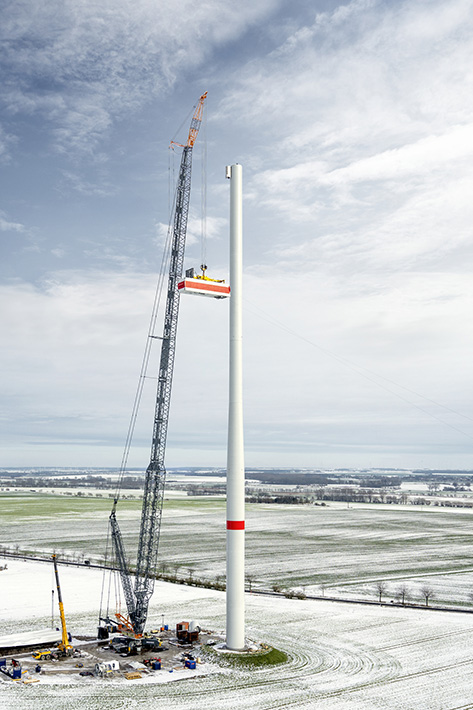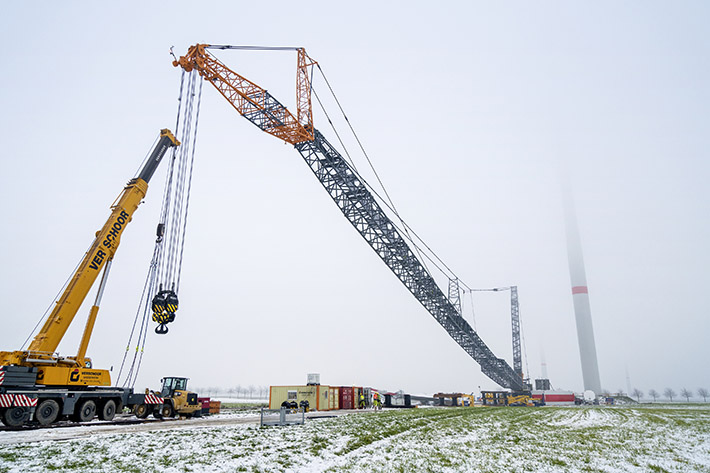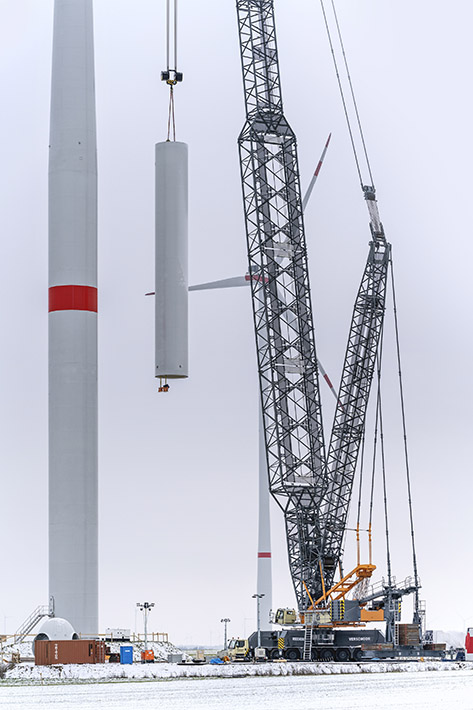Liebherr has distributed to customers its innovative SX2 and SX3 boom systems for crawler and lattice boom cranes. Also, the reinforced booms are particularly helpful for wind power crane operations.

The SX3 version delivers a major increase in lifting capacity of 20 percent and significantly higher wind tolerance compared to the conventional SX version. A new Liebherr LG 1750 crane, which was fitted with the SX3 version, operating at a wind farm in February benefited from these features. The lattice boom mobile crane erected two Vestas turbines in the north-east of Germany with hob heights of 170 meters.
Johan Bezemer, crane operator and part of the four-strong Dutch team at the site close to the German-Polish border, explains:
“The first four tower sections each weighed 120 tonnes, which, when combined with the hook block, meant a load case of around 123 tonnes. With a radius of 35 meters, that meant that we use the full lifting capacity of the crane for this job. This crane with its SX3 boom enables us to increase our capacities, so that we can also erect these very large turbines. Its 165 meters main boom and 12 meters jib gives us a lifting capacity of 127 tonnes. That is really enormous.”
With this boom system, on which the lower section of the lattice boom has been extended to a width of six meters, however, Liebherr is not just reacting to the ongoing increase in the weights of components and hoist heights for erecting wind turbines. The 28 or 42 meters boom reinforcement (which is also fully compatible with the Liebherr LR 1750/2 crawler crane) delivers greater rigidity in the boom design and therefore results in less crane downtime due to wind.
Jens Könneker, Product Manager for Crawler Cranes at Liebherr in Ehingen, says: “The earlier systems used on the LG 1750 were calculated on the basis of a maximum wind speed of nine meters per second. The SX system now allows work to continue in wind speeds of up to ten, or in some cases even 11.2 meters per second“.

On the snowy site where the new Verschoor crane undertook its first job, around 100 kilometers north-east of Berlin, the wind gauge at the top of the boom often provided the answer to the question of whether work was possible on any given day. Bezemer counts up the number of times when the greater wind tolerance of the SX3 boom system meant that the Dutch team could continue to work with their crane: “I think we managed to save around three working days“.
After all the tower segments had been assembled, the lattice jib had to be extended to 15 meters using an intermediate section so that the crane could provide the hoist height required for the other components, including the 100 tonne gondola. The team from Verschoor required just two hours to modify the jib; the time required to lower the massive lattice boom was definitely reduced to a minimum as the LG 1750 was also fitted with the ‘VarioTray‘ detachable ballast pallet. The 415 tonnes of suspended ballast were actually only required to raise or lower the gigantic boom. The centre section of the counterweight, which can be detached from the remainder using bolts and remains on the derrick boom, was all that was required for the actual hoisting work. “That saved us an enormous amount of time and effort. We can get straight on with the job without having to first stack or remove all the ballast“, says Bezemer.

After spending several weeks in Germany, the team from Verschoor returned to the Netherlands with their LG 1750. Since then, the crane has been working full-time on erecting wind turbines in the north of the kingdom using its SX2 boom. The new crane is now the most powerful machine in Verschoor’s fleet. Erik Hans van de Kop, the company’s Managing Director, says: “We will probably only use the LG 1750 for wind power jobs”.
Source: Liebherr


 Copyright 2017-2023 All rights reserved.
Copyright 2017-2023 All rights reserved.